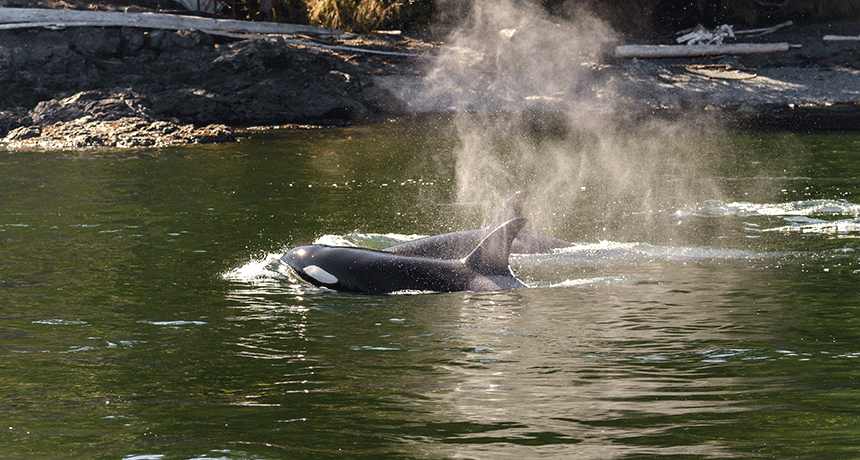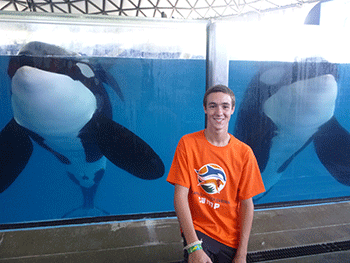Orca snot leads to a whale of a science-fair project
Young scientist studies a gene to probe whether there is more than one species of killer whale

When killer whales surface to breathe, they start by expelling a mist — called a “blow” — which contains some of their DNA. A teen used DNA collected from that mist to look for a potentially key genetic difference in whales from several pods.
sergioboccardo/iStockphoto
By Sid Perkins
PITTSBURGH, Pa. — Killer whales have a distinctive black-and-white, almost tuxedoed appearance. But some groups of these orcas hang out in different areas. Their overall coloration can vary, too. Some groups of these whales even choose to dine on totally different prey. Such divergent traits have led some scientists to propose there might be more than one orca species. But a teen researcher’s new analysis now challenges that.
Orca (Orcinus orca) is the world’s largest dolphin. Its family groups, known as pods, keep pretty much to themselves, notes 18-year-old Luke Harris. He’s a 12th-grader at West Islip High School on New York’s Long Island. A pod’s relative isolation might, over time, lead different populations of the whales to evolve into separate species. Other factors also have suggested there might be at least two orca species. For instance, orcas in some groups eat only fish, such as salmon. A second type will also prey on seals and dolphins. The backs of individuals in some groups are a dark gray, not true black. Finally, some groups of orcas have white patches that are notably larger, on average, than are those on others.
Luke decided to use DNA to settle the question of how many species of orca exist.
Previously, researchers studying other whales, including humpbacks, had shown that it’s possible to get DNA from their “blow.” That’s the spray of mist exhaled through the blowhole as these marine mammals surface to breathe. There’s mucus in that mist, notes Luke. And where there’s mucus, there’s DNA.
Luke enlisted people at SeaWorld to help collect mucus samples from 22 of the orcas at their parks in Florida, Texas and California. Those orcas had come from different pods. He thought the DNA from these individuals might help him learn whether they also represented more than one species.
For his analysis, Luke looked at a gene. This short stretch of DNA is called MT-CO1. The “MT” means that this gene comes from a cell’s mitochondria (My-toh-KON-dree-uh). Those mitochondria, which produce energy in a cell, are passed down to offspring only by females. The “CO1” part of the gene’s name stands for the protein it produces. This protein — an enzyme known as cytochrome (SY-toh-krohm) c oxidase I — speeds up a biochemical reaction that produces water.
Luke chose to analyze this bit of DNA because scientists had shown that its makeup can differ somewhat from one species to another.
The teen’s study was the first to extract DNA from the mucus of orcas. The MT-CO1 gene was the same in every whale that he studied. Based on these data, it would seem that all orca pods represent the same species. However, he adds, looking at other orca genes might turn up genetic differences between pods.

Now the teen plans to turn his attention to finding out the best height at which to collect mucus from an orca’s blow. The folks at SeaWorld had collected it on petri dishes held about 30 centimeters (1 foot) above the blowholes. That’s quite close to a whale. But the SeaWorld team could do it, Luke notes, because its orcas had been trained to briefly ascend, upon command, onto a pool deck. At sea, using a drone might be a safer and more reliable way for researchers to sample that spray from whales.
In the past, scientists have used small darts to collect tissue from orcas. But that has its drawbacks. Darts leave a small wound, for instance, that can get infected. Being hit with a dart is painful, too. For example, an orca that’s been darted learns to avoid boats and stays underwater longer than normal when boats are near, Luke points out. Such activity changes would hinder the ability of researchers to study how orcas behave in the wild. Collecting blow via drone, Luke says, should be a kinder, gentler way to study these marine mammals.
The teen shared his results here, last week, at the Intel International Science and Engineering Fair (ISEF). Society for Science & the Public created the competition and has been running it since 1950. (The Society also runs Science News for Students and this blog.) Sponsored by Intel, this year’s competition saw almost 1,800 students from 81 nations, regions and territories vie for roughly $5 million is prizes and scholarships. Nearly one-third of all finalists took home some sort of award.







